The City's Heritage Permit Review Committee has tabled a report requesting a demolition permit for most of James Street Baptist Church.
By Joey Coleman
Published September 26, 2013
The City's Heritage Permit Review Committee has tabled a report requesting a demolition permit for most of James Street Baptist Church. According to the 129-page report, which the committee only received at the start of the September 25 meeting, the building is structurally unsound and should be demolished before winter to protect public safety.
The developer provided the 129-page report to staff in advance of the meeting.
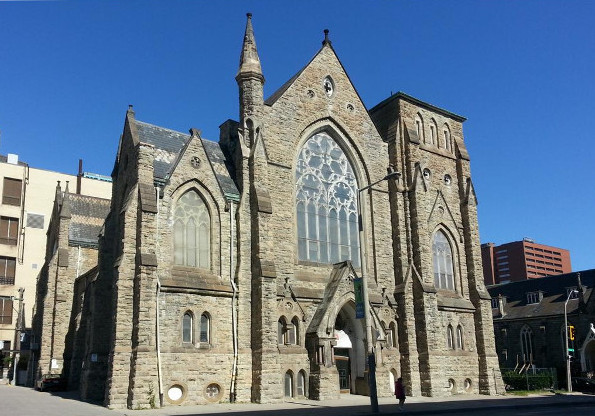
James Street Baptist Church (RTH file photo)
The sudden appearance of this report just before the meeting is highly irregular. It was not included with the agenda, which was made available late on Tuesday afternoon. Further, documents in addition to the report were shared with committee members but have not yet been made available to the public. Worse still, the committee meeting was scheduled at the same time as this week's City Council meeting.
(Note: I was in attendance at the Committee meeting while a volunteer operated the camera to livestream Council.)
A hearing for as important an issue as the proposed demolition of James Street Baptist Church should not take place at the same time as Council, and copies of the report should have been made available to committee members and the public with enough advance notice to read it.
According Louie Santaguida, the property owner, Richard Ramos, president and CEO of Stanton Renaissance, and architect Drew Hauser of McCallum Sather Architects, the building is structurally unsound and most of it cannot be salvaged. Only the front towers and front wall will remain.
In the following slide, the shaded area will be retained:
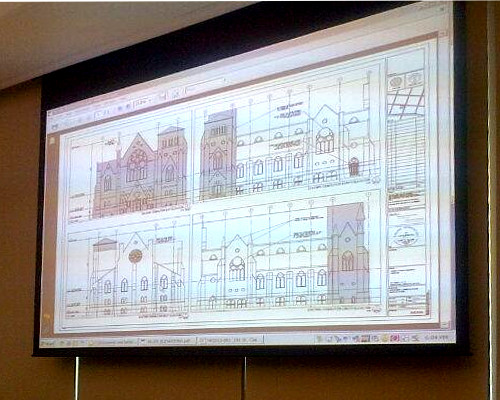
Only the shaded area will be retained
Here is an overhead view. Again, only the shaded area will be retained:
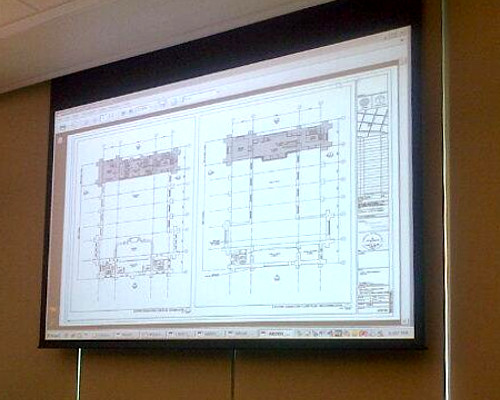
Overhead view: only the shaded area will be retained
Four separate professional reports independently confirm that the building has very serious foundation/structure issues.
According to structural enginner Grant Milligan of Quinn Dressel Associates, church use is hard on buildings, due to factors such as inconsistent heating, which is "cranked up Sunday morning" and then turned down for the rest of the week. He said temperature variations, such as freeze-thaw cycles, are especially damaging upon stone buildings. The north side of the church, with no sun exposure, is especially damaged.
Hauser said they reviewed all options, but there are "significant problems with the interior and foundation" of the building.
Milligan said the interior walls are bulging up to 6.5 inches at chest level in some places. He warned that the building is in danger of partial collapse due to the deteriorating condition of the walls.
Hauser added that the mortar is collapsing in multple parts of the fountain. He said that to fix it, the whole building would have to be taken down anyway.
According to Hauser, there was no engineer supervising the foundation when the church was built between 1878 and 1882, and that it experienced a partial collapse during construction. They found the problems in the main part of the building were due to poor construction and maintenance and the use of cheap fill between the stonework.
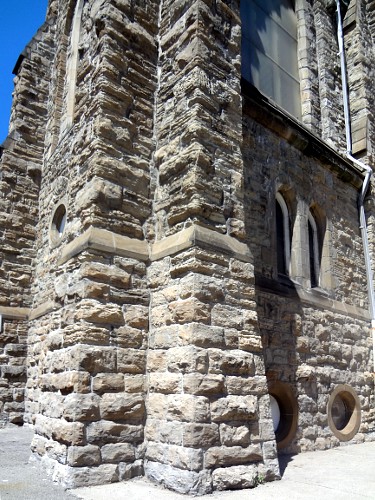
Stonework detail (RTH file photo)
Defending the partial demolition request, Hauser said the whole building cannot be saved, and that all other potential buyers wanted to take down the entire building. Hauser said he wanted to work with the owner because they share a desire to save as much of the building as possible.
The owner spoke passionately of his work on heritage, noting that he has a proven track record. "It's easy for me to say demolish it," said Santaguida. "I don't want to do that. We want to keep as much of the building as possible."
"Others were going to demo the building," he said. "I thought it could be saved ... the unfortunate part is it is not structurally sound."

(L to R) Grant Milligan, Stanton Renaissance land development director Richard Ramos, and Louie Santaguida at the meeting.
The owners have not yet presented a redevelopment plan for the building, though they did present a concept tower behind the building to conceptualize how new would blend with old.
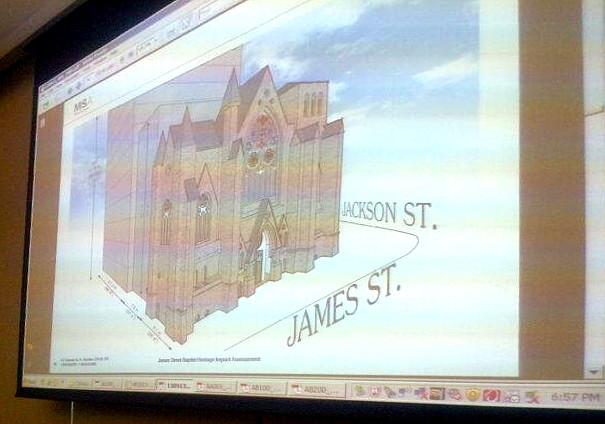
Rendering of a new tower
It is not reflective of any plans. Hauser said they need to do further market research to determine the appropriate development and height before presenting a development plan.
They are requesting a demolition permit now, according to Hauser, because they believe the building cannot survive another "freeze-thaw" cycle over this coming winter. He warned that public safety may be at risk from the slate roof falling onto the sidewalk. The structural engineer agreed that the building needs to come down before winter.
The heritage review committee was skeptical of the professed need to move quickly on demolition, saying they have "heard these stories of doom before."
A committee member asked, "If this building is so terrible, what makes the part you are keeping so different?"
Hauser replied, "It will be a significant challenge and investment to keep it," but "it can stand on its own foundationally." Unlike the sanctuary, it is not in imminent danger of collapse.
The committee was very unhappy at the prospect of issuing a demolition permit with no idea of what the future development will be. They also expressed concern whether the new development will block the view of "the only stone steeple in Ontario" - St. Paul's Church on 70 James Street North, at the northwest corner of James and Jackson.
The committee asked what will happen to the stained-glass windows, trim, hardwood and other architectural features. Hauser said the question is addressed in the 129-page report.
However, the committee protested that they had not been given a chance to read the report, as they were just given copies at the start of the meeting.
Hauser said he thought that city staff would have given copies of the report to the committee sooner. Staff replied that it is not their practice to give committee members individual copies of reports before hearings.
Hauser also said the columns in the church are beautiful and that they will keep them if it can be done safely.
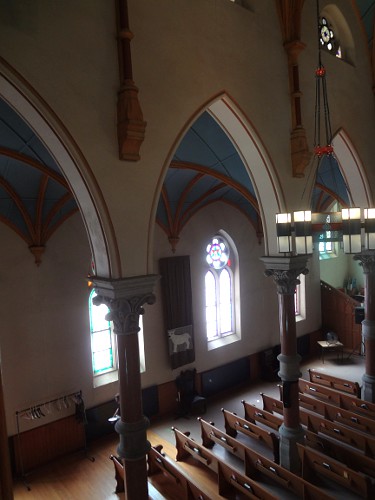
Interior columns and arches (RTH file photo)
The chair requested a site visit. The consultant said he was "very concerned" for safety, and the visitors will require hard hats. City staff at the meeting said they visited the site before the sale and did not issue any unsafe orders.
In the end, the Committee voted to table the report. They will review it again in an upcoming meeting on October 9 at 12:00 PM after a site visit.
I've requested a copy of the report, which is now a public document and will post as soon as I receive it.
I will livestream the October 9th meeting.
If you wish to get a copy of the agenda, which is not posted by the City of Hamilton, you must email clerk@hamilton.ca and request the agenda. You may also request the clerk to send you all agendas for all public meetings.
James Street Baptist Church was designed by Gothic architect Joseph Connolly (it was the only non-Catholic church he designed) and built between 1878 and 1882. It is designated under the Ontario Heritage Act.
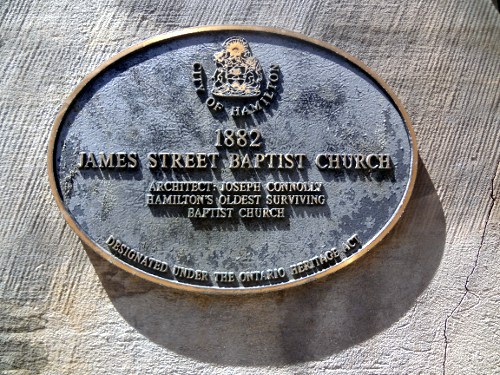
Designation plaque
It was put up for sale in 2012 so the church community could relocate to a more affordable building. The building was sold in February 2013 to a developer from Toronto with plans to incorporate the building into an adaptive reuse that includes a new structure.
Hauser, the architect working on the building, is an intern with the Canadian Association of Heritage Professionals.
with files from Ryan McGreal
By Conrad664 (registered) | Posted September 26, 2013 at 07:38:40
Hear we go again more TAX PAYERS MONEY INTO A WILD FIRE again and again !!!!!!!!
When you go to Quebec whether you are religious or not, you visit these old churches because you love history and architecture. What a shame to lose such a historic wonder.
Why don't the world body of churches support one another in the preservation of these old gems instead of counting on local, aging, and in some cases diminishing congregation populations. This building should have been a tourist attraction on off days. Likely have never been in there myself and now in a place where I wish I could be a fly on a hard hat in that tour.
By AnjoMan (registered) | Posted September 26, 2013 at 08:19:11 in reply to Comment 92630
Is it really the churches job to be maintaining buildings so they can be public attractions? I'm wondering what people think about this in comparison to something like the Gore park buildings.
My gut feeling is that it is unfair to ask a group of non-expert volunteers to put their own money behind preserving a church building when the value of that historical preservation is exclusively as an architectural artifact to the public. Most congregations in these buildings, though they may like being in them, are there because their congregation has owned the building since it was built 150 years ago - it seems unfair that now we want to hold them to maintaining those buildings - at considerable expense - just so we can tour them on off days and gaze at the beautiful architecture.
On the other hand, you could apply similar arguments to a building like the Gore park century buildings that Wilson-Blanchard wants to demolish - why is it their problem that we all of the sudden think of those buildings as valuable artifacts and expect them to spend money on preserving them? (I realize that this ignores the better option of 'historical reuse', which would seem more beneficial in the long run for both parties). Is there a difference here?
By lawrence (registered) - website | Posted September 26, 2013 at 09:39:14 in reply to Comment 92634
True, so then how about a world organization of heritage? Are there cities like the Paris' in the world who have perhaps preserved all their built heritage and are more so in maintainance mode rather than panic mode/early list building mode.
Tourism is something the entire world wants to promote whether its their city or not. Tourism is obviously important to our world economy and visiting museums and places of historical significance are obvious attractions.
We all know our public purse is full of lint so what are other options for us to get caught up on preservation and repair so that we might find ourselves in maintainance mode ourselves?
We've lost too much lately and we are only going to lose more as we stumble through the early stages of figuring out what to do about that list we are creating and still adding buildings too.
By Conrad664 (registered) | Posted September 26, 2013 at 07:46:54 in reply to Comment 92630
You what its a simple thing that is caleed MAINTENANCE
By pearlstreet (registered) | Posted September 26, 2013 at 11:01:43 in reply to Comment 92632
I can't imagion how much it would cost to maintain this place, just look at it!
By Conrad664 (registered) | Posted September 26, 2013 at 12:07:04 in reply to Comment 92647
If they whould take time to inspect it once a year from day one it whould be penuts by now
By Noted (anonymous) | Posted September 26, 2013 at 07:52:09
Drew is currently part of the Government Affairs Committee at the Hamilton Chamber of Commerce, and a Chair with the Hamilton-Burlington Society of Architects. In addition to participating in various committees and boards, Drew is a Member of the Royal Architectural Institute of Canada (RAIC), the Canada Green Building Council (CaGBC), an Intern Member of the Canadian Association of Heritage Professionals (CAHP), and is an active member of the Ontario Association of Architects.
http://msarch.ca/studio/people/drew-hauser
"The Ontario Association of Architects will bring its 2015 conference to Hamilton.
It’s believed to be the first time the association has held its annual event in the city.
It normally rotates between Toronto, Ottawa and Montreal. About 1,000 architects expected for the three-day conference will tour the city’s developments and heritage sites."
http://www.thespec.com/news-story/2260032-local-architect-convinces-association-to-hold-conference-in-hamilton/
By Mltrottier (anonymous) | Posted September 26, 2013 at 08:31:00
The City needs to get its own engineers to investigate this.
If I have 10 independent engineering firms investigate something, and 4 of them vote in favor of demolishing it... well, I'll just say I've had four 'independent' firms conclude that it's worth demolishing.
By Steve (registered) | Posted September 26, 2013 at 16:28:17 in reply to Comment 92636
If you are paying the firms bill, then the odds are the report reflects what you want it to reflect.
By hammer_lover (anonymous) | Posted September 26, 2013 at 08:44:58
Looks great!
I don't know who to believe. The guys seem to have a good heritage rep but then they do this last minute stuff that makes you wonder. How does one approach this in a rationale way?
By JoeyColeman (registered) - website | Posted September 26, 2013 at 11:51:56 in reply to Comment 92645
I believe the architect and engineer.
I need to see the documentation to confirm my belief they are proving a true representation of the structural state of the building.
It's very unfortunate that City Hall is not being proactive in disclosing the meeting, and the documents presented.
There is an assumption by some at City Hall that the public cannot be trusted with information.
In this case, I have yet to hear from one heritage advocate who is assuming bad faith on the part of the owner. Nor have I heard from one heritage advocate who is not prepared to accept the possibility the building is beyond reasonable repair.
By conrad664 (registered) | Posted September 26, 2013 at 12:09:44
This is the problem with the city and the privet company they don`t take inspections on a yearly base and that whats happend
By Durand Durand (anonymous) | Posted September 26, 2013 at 19:00:50 in reply to Comment 92651
How often does an engineer inspect the house you currently live in? It could one day be a heritage property...
By kevlahan (registered) | Posted September 26, 2013 at 12:20:09
The big difference between this case and the Gore Park building is that the developers knew it was designated when they bought it, and with designation comes responsibility.
This means there should be a higher standard imposed for what the owners should be required to do, at their own expense. The City must commission a truly independent engineering report: any report commissioned by the owners, whose goal is to re-develop most of the site, cannot be seen as unbiased. Consultants know what their clients want, and rarely come to conclusions that they know would be strongly opposed by their clients.
As in the Gore Park case the owners are proposing saving only the facade and do not have any clear idea of what the rest of the site would look like. And like Blanchard, they are pushing to demolish now and then think about what to to build and how to finance it later. Both owners claim their buildings "are falling down", although Stanton apparently have stronger evidence that at least part of the building has severe structural problems.
However, the claim that they must demolish now seems dubious. This is a building designated under the Ontario Heritage Act, and claims that the building is structurally unsound and will collapse within a few months are surprising. This must be confirmed by a truly independent engineering report commissioned by the city.
As the committee noted, we've seen this claim over and over that a building is "shot", "falling down", "beyond repair", "at the end of its life". Mostly, this has been an excuse to demolish now to avoid future "risk" of heritage preservation orders. These claims may actually be true here, but given recent history Hamiltonians have the right to be extremely skeptical.
The statement that the freeze-thaw cycle is especially damaging on stone buildings (with the implication that stone buildings are not durable) is clearly ridiculous. A properly constructed and maintained stone building will last centuries, and even poorly maintained stone buildings can last for decades of winters without falling down. Europe (and Quebec) is full of stone buildings that have survived centuries of winters, often with little maintenance.
Comment edited by kevlahan on 2013-09-26 12:22:47
By ScreamingViking (registered) | Posted September 26, 2013 at 16:01:11 in reply to Comment 92652
A properly constructed and maintained stone building will last centuries, and even poorly maintained stone buildings can last for decades of winters without falling down.
I agree with you, but "properly" is a key. Note the quote from the architect about that:
"According to Hauser, there was no engineer supervising the foundation when the church was built between 1878 and 1882, and that it experienced a partial collapse during construction. They found the problems in the main part of the building were due to poor construction and maintenance and the use of cheap fill between the stonework."
Maybe that's a valid assessment, though the building has stood for a long, long time.
Comment edited by ScreamingViking on 2013-09-26 16:01:42
By kevlahan (registered) | Posted September 26, 2013 at 16:24:22 in reply to Comment 92668
Maybe, but I am skeptical. The same sort of thing was said about the Lister building and many other heritage buildings that were later restored. It was claimed that the mortar on All Saints was "too soft", although 19th century lime mortars were much softer than today, and softer mortars are still recommended for heritage conservation.
Regarding the "partial collapse", many great European cathedrals suffered partial collapse during construction and are still standing today.
I would imagine that many stone buildings were built without engineers "supervising the foundation" in 19th century Canada (their professional body, the engineering institute, was only founded in 1887).
The fact that it has stood for over 130 years, despite decades of insufficient maintenance, is concrete proof that it wasn't so badly constructed. And, as you later remarked, all this could have been known to the owners before they bought, and yet they were talking about an adaptive re-use back in 2012.
Comment edited by kevlahan on 2013-09-26 16:27:00
By Conrad664 (registered) | Posted September 26, 2013 at 12:45:05 in reply to Comment 92652
Very true once again (Maintenance) is the Key word here
By Fred Street (anonymous) | Posted September 26, 2013 at 12:24:57 in reply to Comment 92652
The Gore Buildings are designated? Or simply of interest?
By kevlahan (registered) | Posted September 26, 2013 at 12:39:39 in reply to Comment 92653
The Gore Park buildings, surprisingly, have never been designated. This is especially shocking for the the pre-confederation ashlar faced William Thomas building. But it could be designated tomorrow, if council (or the Minister of Culture) had the political will.
By kevlahan (registered) | Posted September 26, 2013 at 12:34:44
I just noticed that the developers are quoted in Spec as saying they would preserve the "front third" of the building. This is highly misleading, as the plans shown in the presentation indicate that only about 20% (the front 1/5) would be preserved. There is a big difference between preserving 1/3 and 1/5 of the building ...
This sort of inaccuracy, combined with the agenda irregularities and sudden appearance of the report which did not give time for the committee to read it are making me increasingly skeptical of the claims that 80% of this designated building must be demolished now, now, now.
Comment edited by kevlahan on 2013-09-26 12:34:56
By JoeyColeman (registered) - website | Posted September 26, 2013 at 12:50:46 in reply to Comment 92654
The quote is attributed to the committee co-chair, not the developer's representatives.
The developers did not use, to the best of my memory, the term "front third" during last night's meeting. They did speak about the "front portion" and "front towers"
By kevlahan (registered) | Posted September 26, 2013 at 12:58:37 in reply to Comment 92657
The Spec used the "one third figure" and states that developer says that "more than two-thirds of the landmark building must be torn down as soon as possible". Anyone reading the article would assume that more than two-thirds means "a bit over two-thirds", not 80%. And the "more than two-thirds" is attributed to the developer. The Spec article seems to have been changed, as it no longer uses the phrase "front third".
Comment edited by kevlahan on 2013-09-26 12:58:48
By Fred Street (anonymous) | Posted September 26, 2013 at 13:02:24
I appreciate that it was probably a fast and dirty render but the proposed tower is looking decidedly soul-deadening.
By Fred Street (anonymous) | Posted September 26, 2013 at 13:27:52 in reply to Comment 92659
Skimmed past the salient detail:
"The owners have not yet presented a redevelopment plan for the building, though they did present a concept tower behind the building to conceptualize how new would blend with old.
It is not reflective of any plans."
By Ian (registered) | Posted September 26, 2013 at 13:04:58
I don't believe that there are any substantive allegations or evidence of bad faith based upon what I've read, but proper disclosure is a must in situations such as these. I have no reason to doubt that the parties seeking the permit have their professed commitment to heritage, so this shouldn't be an issue, and hopefully the next meeting will see a comprehensive review of both the information that is currently available, and any other information which would allow the Committee to make the appropriate recommendation.
The financial state of mainline churches is well-known, and as nice as it would be to be able to preserve all of the historical churches of Hamilton, the appetite and the means to do so is sadly lacking.
I was surprised to read that there are no plans for the use of the property, save and except for a tower behind the James Street frontage of the building. The condition of the building has been known for a number of months.
By kevlahan (registered) | Posted September 26, 2013 at 13:12:54 in reply to Comment 92660
The public has every reason to be skeptical and demand full disclosure, given recent history. The consulting architect does have credentials in heritage, but the proposal to demolish 80% of a designated building is shocking and demands a high level of proof.
The condition of the building has NOT been known publicly for a number of months. I'm pretty well connected on these things, but the only piece of information I had was that the North wall was in bad shape. And this was not public information (where was it published?).
No one is proposing saving "all of the historical churches of Hamilton". But we should at least take every effort to preserve the historically designated ones ... that is why they were designated in the first place. We are already going to lose All Saints and probably the stone church near Canadian Tire, and Ascension is at risk. I don't see any evidence at all that we are preserving even the most significant 19th century stone churches, let alone "all" of them. Is there a single historically significant stone church in Hamilton that has been preserved once it no longer has a religious use? If there is, I am not aware of it.
Comment edited by kevlahan on 2013-09-26 13:16:14
By JoeyColeman (registered) - website | Posted September 26, 2013 at 13:08:06 in reply to Comment 92660
The tower is purely illustrative for the committee to see an idea of setback.
There are no plans, I'm hopeful to have the 129 page report by the end of the day.
By Stinson_Resident (anonymous) | Posted September 26, 2013 at 13:43:12
An immediate concern is serious structural problems on the building’s north wall, says Hauser. Other areas will require stabilization as well.
We’re praying the city will allow flexibility, said Clause. Otherwise, (the church) will fall down and be of no use to anyone.
A building condition report before it was listed said the structure needs $2 million to $3 million worth of work.
February 13, 2013 - The Spec - Prayers for redevelopment at James Street church
By whatevs (anonymous) | Posted September 27, 2013 at 00:48:01 in reply to Comment 92666
Its been standing what, 150 years? The church is suddenly in imminent danger of falling down now?. Because they turned the heat on every Sunday? The thing was built before central heating existed. Gimme a break. They knew what they were getting into when they bought it. They don't Ike it? They can sell it at a loss. Not our problem they are incapable of due diligence...
By ScreamingViking (registered) | Posted September 26, 2013 at 16:04:44
Wouldn't the property owner have done this kind of analysis as part of their due diligence before buying the property? Maybe not as in-depth, but enough to know if there were things that should be looked at more closely?
I just don't get that. You don't spend a lot of money on something without minimizing the risk of major surprises.
By JoeyColeman (registered) - website | Posted September 26, 2013 at 16:37:10
The 129-page report can be downloaded from here: http://www.joeycoleman.ca/2013/09/26/her...
or here:
By Churched 101 (anonymous) | Posted September 26, 2013 at 22:42:55
It's interesting to see all of these comments ... but the reality is that preserving old buildings is a prohibitively expensive endeavour. Church communities are dwindling, charitable givings are dwindling, and the function of the church is NOT to preserve buildings. Heritage designations were sought by numerous churches two to three decades ago because along with the designation came funds to help maintain buildings in need of major restoration. Now that funding has all dried up and the designated properties are in need of further restorative work. Congregations have no choice but to sell their buildings and quite frankly who wants to buy a building with a designation that is going to tie their hands for ever and ever. I too love old buildings and there is nothing like the sound of a pipe organ on Christmas Eve but at some point all good things come to an end. Maybe this is the end.
By erskinec (registered) - website | Posted September 28, 2013 at 10:46:26 in reply to Comment 92680
For the majority of Church properties, the issue is declining congregations and their ability to afford maintaining the buildings.
With regards to St. Mark's, there is some exciting proposals on the table to make use of the property. There was an open house during the summer to get public feedback. Top marks to the organizers for creativity on adaptive re-use.
The challenge of church buildings needing new uses is very common in North American and European. The good news is that there are many exciting adaptive re-uses for churches: from bars and restaurants to condo towers. Most Churches are of a size that a individual or a group of friends can buy the properties. There are many examples of churches being turned into artist studies and galleries.
In reality, few historic churches need to be demolished unless there are structural problems. There is a demand out there for these buildings, it appears only in Hamilton would there be a problem.
By creativity (anonymous) | Posted September 27, 2013 at 18:08:25 in reply to Comment 92680
Someone with money should have bought that place and turned it into a brewery. But the city probably wouldn't let them. All the city understands is tearing stuff down and building suburban crap on the empty lot. I weep for the future.
By J (registered) | Posted September 26, 2013 at 23:01:58 in reply to Comment 92680
I agree. If heritage designation is a scarce public resource, let's put it to Delta and King George not these churches. The city has pumped hundreds of thousands into St Marks and all it will ever be is a useless though lovely relic. Heritage designation isn't about aesthetics, it's about integrating buildings into the city's future. For most urban churches the reality seems to be that neither the churches nor the private sector are able to do anything with them.
By j. frost (anonymous) | Posted September 27, 2013 at 09:05:47
seems pretty clear to me, they bought a designated building which means it can't be knocked down. they didn't do their research or are paying engineers to exaggerate the structural problems. so fix it. i don't care if its expensive, thats part of the reason the building was so cheap. its the lister block all over again. don't buy old designated buildings if you don't want to fix them.
they say it won't survive another freeze thaw cycle, so heat the place and it won't freeze. if it needs to be supported then support it.
its all just another big scam to get the city to pay millions of dollars to a private developer
By Norb (registered) | Posted September 29, 2013 at 12:16:24 in reply to Comment 92692
Of course it's a scam, the building has lasted this long already. Why would it suddenly be in danger of falling down now that it has been purchased by developers. what's next...a mysterious fire that destroys the old heritage building...just like the old Shaver House in Ancaster, just off Highway 2 at the junction of Shaver's Road?? A piece of property purchased by a developer with a significant heritage structure on it, only to have the house burn down mysteriously so it has to be levelled??
By LoveIt (anonymous) | Posted September 27, 2013 at 19:16:04 in reply to Comment 92692
I cannot believe that there is no way to underpin the building, to re-build the roof and re-inforce the structure. This beauty could make one-of-a-kind concert hall/restaurant/convention centre. It's not always the bigger that makes more money but unique quality that maximize the profit. Boutique hotel is not the best use for this gem.
By Norb (registered) | Posted September 29, 2013 at 12:20:26 in reply to Comment 92721
Why not preserve it in its entirety as it was built, for the role that it plays. That is what they do to heritage buildings in Europe...the locals are proud of their heritage and prove it by complete architectural preservation. Perhaps we seem to be too young a country to have a heritage to protect.
By J (registered) | Posted September 27, 2013 at 18:42:34 in reply to Comment 92692
few commenters on this site understand heritage designation. Many designated buildings have been knocked down. Designation only preserves elements of a building, and most of the time just the exterior, and even then you can always negotiate to save just a portion.
By Norb (registered) | Posted September 29, 2013 at 12:25:52 in reply to Comment 92718
well, J, that may be what happens in Canada. In Europe and other countries they attempt to preserve whole buildings of cultural significance. Maybe we, in Canada are more concerned about profit than preservation of cultural heritage. Maybe Canada is not a country old enough to believe its cultural heritage merits preservation. Maybe we are too young to realize the significance of preserving our cultural heritage through preservation of historic architecture
By kevlahan (registered) | Posted September 28, 2013 at 11:29:42 in reply to Comment 92718
Your information is a bit out of date. The Act used to allow demolition as of right after a waiting period, but that is no longer the case.
The Act was modified a few years ago so that it normally prohibits demolition, i.e. a demolition permit is not granted as of right after a certain waiting period. This is what the Act says: http://www.e-laws.gov.on.ca/html/statute...
No owner of property designated under section 29 shall demolish or remove a building or structure on the property or permit the demolition or removal of a building or structure on the property unless the owner applies to the council of the municipality in which the property is situate and receives consent in writing to the demolition or removal. 2002, c. 18, Sched. F, s. 2 (18); 2005, c. 6, s. 22 (1).
In other words, the owners must convince council to grant permission to demolish, which is why the owners of this church are arguing it is structurally unsound and would be expensive to repair. Council doesn't have to agree, but the current council is pretty indifferent to heritage so arguing that fixing the building would be expensive has a good chance of working.
Designation prohibits modification of specified elements, and almost always prohibits demolition of the structure that includes the elements.
Comment edited by kevlahan on 2013-09-28 11:33:51
By J (registered) | Posted September 29, 2013 at 22:40:08 in reply to Comment 92737
Can't respond to you because my response keeps getting flagged as spam, but you have the law kind of right but the practice wrong.
By Danielle (anonymous) | Posted September 27, 2013 at 10:42:32
I live across the street from this beautiful church. I walk by it every day and admire the history. I was wondering what was happening with it and surely thought the city would never let someone tear down such a beautiful piece of history and architecture. Shame.
By Norb (registered) | Posted September 29, 2013 at 12:26:28 in reply to Comment 92702
I am in total agreement with you, Danielle.
By kevlahan (registered) | Posted September 27, 2013 at 11:13:54
Well, the Spec story is now back to stating erroneously that the developer is going to preserve the front third:
"But Wednesday, the subcommittee learned the developer feels he can preserve only the front-third of the building, including the iconic stone entrance and tower. "
http://www.thespec.com/news-story/412508...
There is a big difference between demolishing 80% (as the developer is proposing) and 67% as the article states. Why can't they get this basic fact right?
The owners should be told to heat and stabilize the building until they have a re-development plan in place. At which time the request to demolish 80% of this heritage building can be properly assessed. I would also like to see an independent study by structural engineers who have experience with heritage stone buildings ... Quinn Dressel do not describe any heritage work on their website http://www.quinndressel.com/ and seem to specialize in large office buildings and other modern construction: "Specializing in high-rise commercial construction, healthcare, institutional and building science projects."
Comment edited by kevlahan on 2013-09-27 11:14:26
By Narthex (anonymous) | Posted September 27, 2013 at 13:16:37
When does the Design Review Panel arrive?
By TnT (registered) | Posted September 28, 2013 at 10:09:22
I wonder if retired geologist Gerard Middleton is available for a comment, or article?
By Norb (registered) | Posted September 29, 2013 at 12:03:57
It is funny how cities in Europe, such as Dresden have been restoring their architecture; such as the Frauenkirche, an old German church bombed into dust and virtual oblivion during World War 2. They have spent meticulous years and money to completely restore the church to its former beauty because they see the value in cultural icons, beaautiful and historically significant architecture that embodies the historical significance of a culture. Many places do the same as they see and want to preserve the connection to their past which gives them direction in their future visions. Without it we have no visual history, where we came from, what we strived for and what was accomplished. Without that we have no roots and without roots there is no vision that can drive our future. Today we have lost our historical connections to money and profit. This is embodied in the destruction of historically significant buildings, destroyed to make way for profit making souless modern structures and higher property taxes. To save a facade for the sake of historical posterity is at best a lame and cynical attempt to appease the public without any real merit. It is a pale excuse for the preservation of truly beautiful and meaningful architecture. We have nothing to offer tourists in this city as all of our historical buildings are disappearing...who would want to come to Hamilton to see concrete and steel? There is no vision in this city, certainly not from the current city council sitting in chambers. It is a sad commentary on what our city is and is becoming!
By Kiely (registered) | Posted September 30, 2013 at 11:05:57
Hauser added that the mortar is collapsing in multple parts of the fountain. He said that to fix it, the whole building would have to be taken down anyway.
I'd tell you to proof read and not just spellcheck Joey but it appears you do neither.
Comment edited by Kiely on 2013-09-30 11:06:24
By JoeyColeman (registered) - website | Posted September 30, 2013 at 11:46:57 in reply to Comment 92778
Some copy errors will occur and will make it to publication. As much as I strive to prevent them, writing an article within hours of a meeting, while managing videos, and covering a City Council meeting that same evening increases the likelihood of cosmetic errors.
I hope this explains how this occurs.
By Terri (anonymous) | Posted October 08, 2013 at 02:02:21
It seems the owner, developer and engineering consultant are synthesizing a false crisis situation, trying to scare the city into rushing into demolition. They'll probably only retain the parts of the structure they find financially expedient to work with. We should keep cool, think carefully, and insist they follow procedures. We need solid evidence before we believe their claim that the structure will be a hazard if exposed to another freeze thaw cycle this winter.
You must be logged in to comment.
There are no upcoming events right now.
Why not post one?